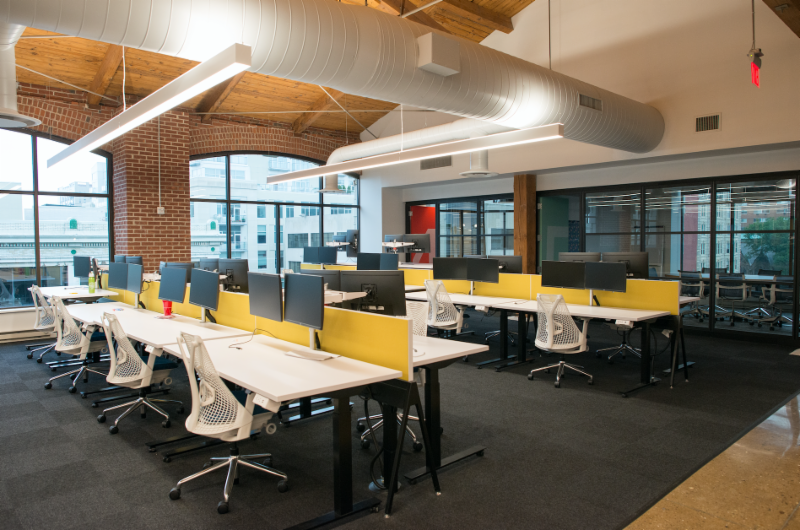Hoteling and Open-Plan Office Spaces

According to Fortune Magazine, on any given day, up to 30% of staff may be out of the office between business trips, vacations, sick days and offsite meetings. To make better use of their investment in work-space, many companies have begun offering a model of desk-sharing (workers sit where they want), by embracing “Hoteling”, which is an alternative approach to the more traditional method of permanently-assigned cubicles or seating. The hoteling model (also called hot-desking) effectively reduces the square footage needed to support a company’s workforce (reducing real estate costs) and creates open spaces for on-site employees to use for collaboration.
Top 5 Reasons to Adopt Hoteling in Your Workplace
1. It Improves and Supports the Telecommuting Experience
For employees who already work remotely most of the time, office hoteling encourages them to visit “home base” every once in a while. It gets them in the office, mingling face to face with coworkers and management, and spending time immersed in their organization’s culture. Likewise, if employees don’t already telecommute, adopting office hoteling will make it easier for them to do so.
2. Ensure Fair Access to Office Resources
We’ve all experienced that one co-worker whose time is more valuable than anyone else’s, whose deadline is more pressing and who hordes shared office equipment and supplies in their workspace. Office hoteling evens the playing field and provides management with greater control over workspace, equipment and other resources to ensure all employees have fair access to what they need, when they need it. For example, if a team member has a big print job scheduled for the day, they can reserve the workstation closest to the copy room.
3. Encourage Greater Collaboration and Teamwork
When space and resources aren’t being allocated based on rank and instead are available to all employees as needed, people are more inclined to collaborate with one another and the coveted “team mentality” all modern organizations are striving to develop occurs organically. Not all employees require the same workspace to reach their peak productivity level. Some prefer quiet, independent space. Some do best in group settings or amid the bustle and energy of an active, open office. Office hoteling is one way organizations can provide their employees with the option to choose.
4. Increase Space Optimization
Why assign a permanent desk to an employee who spends a majority of their time working from home or on the road? Hoteling eliminates unnecessary workspaces and enables organizations to reduce the overall square footage needed to support their workforce. By getting down to the essentials, space can be reconfigured to better support the workflow and collaboration of on-site employees while still catering to the needs of remote workers who sometimes require in-office time.
5. Reduce Overhead
If an organization can reduce its square footage, it can also reduce its rent, energy consumption and utility costs. The less spent on rent and utility means more capital to reinvest back into the business.
The proper adoption of office hoteling will require that your organization implement space management and reservation software. Integrated Workplace Management Software (IWMS) seamlessly integrates these systems and allows you to clearly and easily observe how every person interacts with every square inch of your facility and how they interact with all resources and assets.
(source: www.iofficecorp.com/blog/5-reasons-your-workplace-should-adopt-office-hoteling)
LightWerks can integrate state-of-the-art technologies that are designed to support highly collaborative, mobile, and flexible environments. Fast, easy connectivity is vital in an open-plan office space – team members need hassle-free solutions to set themselves up and connect anywhere. And wireless mirroring, and seamless cloud conferencing, using BYOD sources, must be supported .
Our hoteling solutions include systems from vendors like Crestron that allow room-scheduling, workstation- scheduling, and unified collaboration from any location in an office. Then combining those abilities with Zoom or other providers enables video communication throughout an enterprise.

